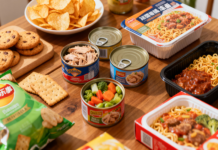Macro-friendly foods are those optimized for their macronutrient profile—most often high in protein, lower in fats and carbs, and providing more food volume for fewer calories. The term is popular among people tracking their macros (protein, carbs, fat) for specific fitness or weight loss goals.
Foods described as macro-friendly often have a higher protein-to-calorie ratio, making them supportive of muscle-building or fat-loss diets.
Often, these foods are processed or modified versions of traditional foods (e.g., protein wraps, low-fat sauces, sugar-free syrups) to help meet calorie or macro targets while feeling fuller and more satisfied.
Macro-Friendly Example Swaps
| Food Type | Regular Option (Actual Food) | Macro-Friendly Substitute |
|---|---|---|
| Mayonnaise | Full Fat: 90cal/10g fat/0g prot/0g carb | Fat-Free: 10cal/0g fat/0g prot/2g carb |
| Tortilla | Flour Tortilla: 300cal/10g fat/7g prot/46g carb | Joseph’s Lavash: 100cal/4g fat/10g prot/14g carb |
| Ranch Dressing | Hidden Valley: 145cal/15g fat/0g prot/2g carb | Bolthouse Farms: 45cal/3g fat/1g prot/3g carb |
| Syrup | Aunt Jemima: 210cal/0g fat/0g prot/52g carb | Cary’s Sugar-Free: 20cal/0g fat/0g prot/5g carb |
Pros of Macro‑Friendly Foods
-
- Help you eat larger portions for the same or fewer calories
- Facilitate easier adherence to calorie/macro-based diets, crucial for weight loss or muscle building
- Prioritize protein intake, supporting satiety and muscle maintenance
Limitations & Considerations
-
- Macro-friendly foods can be heavily processed to fit specific dietary goals. They may lack the micronutrients or other health benefits of whole, minimally-processed foods.
- Focusing solely on macros can lead to choices that neglect food quality, fiber, vitamins, and minerals.
- Long-term health is best supported by a foundation of whole foods: fruits, vegetables, whole grains, legumes, lean meats, nuts, and seeds, which provide nutrient density beyond macros.
Macro-Friendly vs. Actual (Whole) Food
Actual food (whole food) refers to minimally processed, nutrient-rich foods that naturally contain both macro and micronutrients essential for overall health.
Macro‑friendly foods prioritize macro ratios and calorie control but may lack the complexity and nutritional value of whole foods.
Personal Thoughts
Whenever I think Macro-friendly, I often imagine some scientist in a lab somewhere pouring over a stack of spreadsheets.
Whenever I think of actual food, I’m reminded of how I’ve eaten the real deal my entire life. Whole milk, cheese, butter, beef, salad, sugar, and so on and so forth.
Somehow I’ve managed to stay as close to a real diet as possible though, and even after all of these years my weight has varied ever so slightly from when I was in high school.
Some might call me lucky but I don’t think luck has much to do with it. There’s nothing wrong with a little exercise and sunshine — it does a body good, and so does real food.







